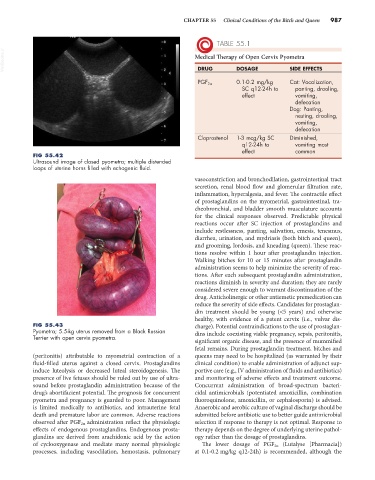Page 1015 - Small Animal Internal Medicine, 6th Edition
P. 1015
CHAPTER 55 Clinical Conditions of the Bitch and Queen 987
TABLE 55.1
VetBooks.ir Medical Therapy of Open Cervix Pyometra
DOSAGE
SIDE EFFECTS
DRUG
0.1-0.2 mg/kg Cat: Vocalization,
PGF 2α
SC q12-24h to panting, drooling,
effect vomiting,
defecation
Dog: Panting,
nesting, drooling,
vomiting,
defecation
Cloprostenol 1-3 mcg/kg SC Diminished,
q12-24h to vomiting most
effect common
FIG 55.42
Ultrasound image of closed pyometra; multiple distended
loops of uterine horns filled with echogenic fluid.
vasoconstriction and bronchodilation, gastrointestinal tract
secretion, renal blood flow and glomerular filtration rate,
inflammation, hyperalgesia, and fever. The contractile effect
of prostaglandins on the myometrial, gastrointestinal, tra-
cheobronchial, and bladder smooth musculature accounts
for the clinical responses observed. Predictable physical
reactions occur after SC injection of prostaglandins and
include restlessness, panting, salivation, emesis, tenesmus,
diarrhea, urination, and mydriasis (both bitch and queen),
and grooming, lordosis, and kneading (queen). These reac-
tions resolve within 1 hour after prostaglandin injection.
Walking bitches for 10 or 15 minutes after prostaglandin
administration seems to help minimize the severity of reac-
tions. After each subsequent prostaglandin administration,
reactions diminish in severity and duration; they are rarely
considered severe enough to warrant discontinuation of the
drug. Anticholinergic or other antiemetic premedication can
reduce the severity of side effects. Candidates for prostaglan-
din treatment should be young (<5 years) and otherwise
healthy, with evidence of a patent cervix (i.e., vulvar dis-
FIG 55.43 charge). Potential contraindications to the use of prostaglan-
Pyometra; 5.5-kg uterus removed from a Black Russian dins include coexisting viable pregnancy, sepsis, peritonitis,
Terrier with open cervix pyometra.
significant organic disease, and the presence of mummified
fetal remains. During prostaglandin treatment, bitches and
(peritonitis) attributable to myometrial contraction of a queens may need to be hospitalized (as warranted by their
fluid-filled uterus against a closed cervix. Prostaglandins clinical condition) to enable administration of adjunct sup-
induce luteolysis or decreased luteal steroidogenesis. The portive care (e.g., IV administration of fluids and antibiotics)
presence of live fetuses should be ruled out by use of ultra- and monitoring of adverse effects and treatment outcome.
sound before prostaglandin administration because of the Concurrent administration of broad-spectrum bacteri-
drug’s abortifacient potential. The prognosis for concurrent cidal antimicrobials (potentiated amoxicillin, combination
pyometra and pregnancy is guarded to poor. Management fluoroquinolone, amoxicillin, or cephalosporin) is advised.
is limited medically to antibiotics, and intrauterine fetal Anaerobic and aerobic culture of vaginal discharge should be
death and premature labor are common. Adverse reactions submitted before antibiotic use to better guide antimicrobial
observed after PGF 2α administration reflect the physiologic selection if response to therapy is not optimal. Response to
effects of endogenous prostaglandins. Endogenous prosta- therapy depends on the degree of underlying uterine pathol-
glandins are derived from arachidonic acid by the action ogy rather than the dosage of prostaglandins.
of cyclooxygenase and mediate many normal physiologic The lower dosage of PGF 2α (Lutalyse [Pharmacia])
processes, including vasodilation, hemostasis, pulmonary at 0.1-0.2 mg/kg q12-24h) is recommended, although the

